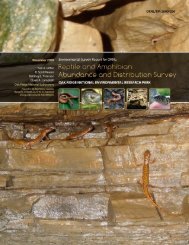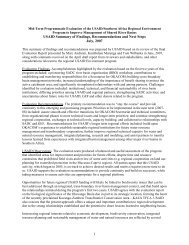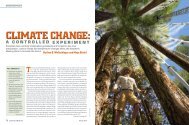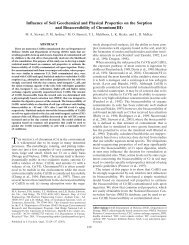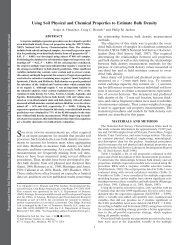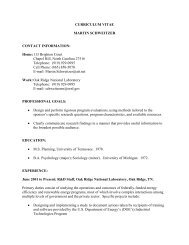oak ridge reservation physical characteristics and natural resources
oak ridge reservation physical characteristics and natural resources
oak ridge reservation physical characteristics and natural resources
You also want an ePaper? Increase the reach of your titles
YUMPU automatically turns print PDFs into web optimized ePapers that Google loves.
corridors; planted hardwoods <strong>and</strong> pines; bottoml<strong>and</strong>s <strong>and</strong> wetl<strong>and</strong>s, including an increasing number<br />
of beaver ponds; caves; <strong>and</strong> developed <strong>and</strong> semideveloped areas <strong>and</strong> roads.<br />
The resulting diversity of wildlife species ranges from common species found in urban <strong>and</strong><br />
suburban areas of eastern Tennessee to species with more restrictive requirements, such as interior<br />
forest bird species. The ORR hosts more than 70 species of fish; about 45 species of reptiles <strong>and</strong><br />
amphibians; more than 200 species of migratory, transient, <strong>and</strong> resident birds; <strong>and</strong> more than 30<br />
species of mammals, as well as innumerable invertebrate species. Tables B.1, B.2, <strong>and</strong> B.3 list the<br />
fish; reptiles, amphibians, <strong>and</strong> mammals; <strong>and</strong> birds found on the ORR. Among these, 17 species of<br />
federally or state-listed (endangered, threatened, or in need of management) vertebrate species have<br />
been confirmed in recent surveys (Mitchell et al. 1996). Furthermore, appropriate habitat for<br />
approximately 20 additional species has been identified. In addition, 13 of the recorded bird species<br />
are listed by Partners in Flight as species of concern. Monitoring by Partners in Flight has also<br />
determined that 11 of the 16 species that are of top conservation priority in the region are present on<br />
the <strong>reservation</strong> during the breeding season. Table 2 lists the animals of special concern on the ORR.<br />
Updated information on ORR wildlife is maintained online at the Research Park’s Web site,<br />
www.esd.ornl.gov/facilities/nerp.<br />
The Tennessee dace (listed by the state as in need of management) is found in numerous streams<br />
<strong>and</strong> tributaries on the <strong>reservation</strong>, in contrast to declining or absent populations in streams outside the<br />
ORR.<br />
Listed rare species (plants <strong>and</strong> wildlife) occur across the ORR in more than 50 different<br />
locations, which are protected as Research Park Natural Areas. As a result of urbanization, many of<br />
these Research Park Natural Areas contain plants or animals now absent from or uncommon in areas<br />
surrounding the ORR.<br />
9. INTERIOR FOREST RESOURCES<br />
The ORR’s extensive forest area, amounting to approximately 24,000 acres (9,712 ha), is<br />
valuable not only for its size, but also because of its many patches of forest larger than 50 contiguous<br />
acres (20 ha) (Fig. 9). Contiguous forest provides habitat for several plant <strong>and</strong> animal species not<br />
associated with smaller patches of forest. This is especially true for certain increasingly rare bird<br />
species. Deep forest habitat is located away from large openings <strong>and</strong> typically has more than 70%<br />
canopy cover. A minimum of 50 contiguous acres (20 ha) of forest habitat can be used as a<br />
benchmark as the required acreage for the presence of many deep forest wildlife species.<br />
As human populations continue to increase <strong>and</strong> exp<strong>and</strong>, large tracts of contiguous forest are<br />
becoming smaller <strong>and</strong> are broken into a greater number of pieces. Forest area is lost to clearing of<br />
l<strong>and</strong> for industry, agriculture, <strong>and</strong> residential development, <strong>and</strong> the remaining forest is further<br />
fragmented by associated roads <strong>and</strong> utility corridors. Fragmentation creates an “edge effect” that<br />
alters habitat conditions such as moisture regime, microclimate, <strong>and</strong> light penetration <strong>and</strong> can result in<br />
the introduction <strong>and</strong> spread of predators harmful to forest-dependent species. Nesting forest birds<br />
increasingly fall prey to predators associated with edge habitat such as feral cats, raccoons, <strong>and</strong><br />
certain snake species. The creation of cleared areas throughout forests also opens the area to the<br />
brown-headed cowbird, a common nest parasite that uses edge habitat <strong>and</strong> parasitizes nests of forest<br />
birds. Cowbirds fly in from the edges to lay their eggs in the nests of forest birds, where the larger<br />
more aggressive cowbird young out-compete the fledglings of the forest-bird species. As more edges<br />
are created through the forest, cowbird penetration <strong>and</strong> associated nest predation on forest species<br />
such as wood thrush increase.<br />
20




